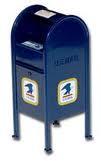While the United States Postal Service publicizes the closing of thousands of post offices nationwide, the laying off of workers, and the end of Saturday delivery, one service the Postal Service offers has been slowly, quietly disappearing: the corner mailbox.
Once a staple in many neighborhoods, the blue mailbox on the corner is now slowly fading into history. Nancy Pope of the Smithsonian Institution commented thus about the significance of the corner mailbox: “Nothing says you’re on an American street more than the blue mailbox. It’s part of a neighborhood identity. It’s reassurance, it represents our ability to communicate with one another. When you take this away, something is lost.” At one time these blue mailboxes were seemingly everywhere. A convenience that perhaps has been taken for granted over the years. Data show the number of United States Postal Service blue mailboxes nationwide.
Geographic reference: United States
Year: 1985 and 2011
Market Size: 400,000 and 160,000 respectively
Source: Bob Greene, “Farewell My Mailbox,” CNN.com, September 8, 2011, available online here. The charming little image used above was obtained from this site, and used with our thanks.
Original Source: Research by Carolyn Jones of the San Francisco Chronicle.
Posted on October 28, 2011

